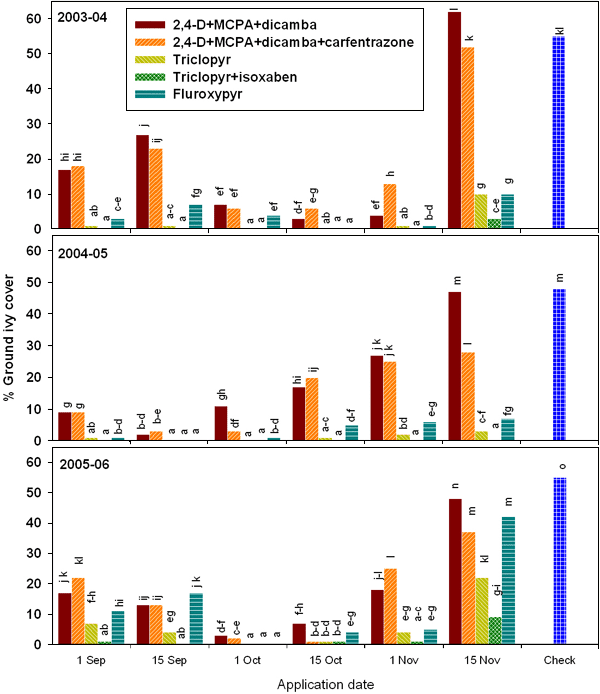Due to the current drought conditions for many in Indiana we have recommended holding off on herbicide applications until rain returns to drought stressed turf. Herbicides are most effective on weeds that are not drought-stressed and herbicides can be damaging when applied to drought-stressed turf. As we continue to wait for significant rains to return to these drought stressed areas the question many are asking is how late in the year can I apply a broadleaf herbicide to control dandelions, white clover, ground ivy and other broadleaf weeds. Generally, the best answer is that broadleaf herbicides can be applied in Indiana until mid-November and still provide effective control. This timing is +/- 2 weeks depending upon your location in the state. Broadleaf week control in Northern Indiana is best by November 1, whereas broadleaf weeks can effectively be controlled in southern Indiana prior to December 1.
Many herbicides are effective in late fall because plants are more likely to translocate (move downward) herbicides into root and stem tissues as the day lengths shorten and the temperatures cool. Typically, this will occur near or following our first frosts which has recently occurred. Previous research shows that 2,4-D and/or dicamba were far more effective in controlling dandelions and Canada thistle when applied 1 to 10 days after the first fall frost than when applied 5 to 11 days before the frost (Wilson and Michiels, 2003). Other work at Michigan State found that “good dandelion control can result from herbicides applied through late October, even when the plants are not actively growing.” (Hanson and Branham, 1988). More recently, research at Purdue by Reicher and Weisenberger (2007) found the following in regards to ground ivy control and application timing (also see Figure 1):
-
November applications of most herbicides resulted in ground ivy control similar to earlier (September and October) applications when rated the following June.
-
Triclopyr was the most effective and consistent in controlling ground ivy.
-
Long-term control of ground ivy from triclopyr was not affected significantly by application date.
-
When using three-way herbicides (2,4-D + MCPP + diacmba) or products containing fluroxypyr, applications on 1 September through 1 November were most effective.
-
Adding carfentrazone (FMC’s Quicksilver, PBI Gordons’ Powerzone and Speedzone) to 2,4-D+MCPP+dicamba dramatically improved short-term control of ground ivy from November applications, but had little long-term benefit on any application date. Products containing carfentrazone will aid in quick “burndown” and immediate customer satisfaction when making fall applications but they may not increase long-term control, especially with ground ivy.
In all cases read the herbicide label before making an application. Read the herbicide label carefully if the area you want to treat has recently been seeded. Most herbicides require that newly seeded turf be germinated and mown 1-2 times prior to a herbicide application.

Fig. 1. Percent ground ivy cover in June as affected by fall herbicide application timing. Means followed by the same letter are not significantly different at P ≤ 0.05. From Reicher and Weisenberger, 2007.
Sources: